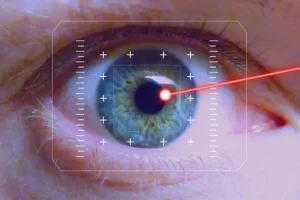Hypermetropia Correction
- Updated on: Nov 16, 2023
- 4 min Read
- Published on Dec 1, 2020

How Is Hypermetropia Correction Done?
Hypermetropia, if left untreated, can lead to blurred vision, binocular dysfunction, amblyopia (eyes fails to achieve normal acuity), and Strabismus (eyes don’t look exactly in the same direction at the same time). Hypermetropia correction is needed to remediate symptoms and to reduce the future risk of these visual problems. Hypermetropia can be corrected using optical correction, vision therapy, medical therapy, and refractive surgery.
Optical Correction
This is the primary treatment available for hypermetropia correction. Here the patients are prescribed the plus-power convex lenses to shift the light’s focus from behind the eye towards the retina.
The clinician should carefully consider the patient’s vision needs to finalize the lens prescription. Either single vision or multifocal lenses may be prescribed. Some patients who do not follow the prescription of spectacles are recommended contact lenses.
Vision Therapy
Vision therapy is an effective treatment for accommodative and binocular dysfunction caused by hypermetropia. Accommodative esotropia, i.e., moderate to high hypermetropia, may reduce binocular skills. These binocular skills can be improved by vision therapy or by wearing a prescribed correction lens.
Medical Therapy
Medication therapy is suggested to such patients who do not want to wear spectacles. Anticholinesterase agents like echothiophate iodide (Phospholine Iodide, PI) and diisopropylfluorophosphate (DFP) are used in hypermetropia patients to reduce the ratio of high accommodative convergence-to-accommodation (AC/A) ratio and to improve the alignment of the eyes at near vision. These drugs mimic the accommodative effect of plus power convex lenses without using spectacles or contact lenses. The potentially serious adverse effects of anticholinesterase agents limit their usefulness.
Refractive Surgery
There are many refractive surgeries still under development to correct hypermetropia. However, some refractive surgeries for hypermetropia correction have evolved, like Holmium: YAG laser thermal keratoplasty, automated lamellar keratoplasty, spiral hexagonal keratotomy, excimer laser, and clear lens extraction with intraocular lens implantation.
What Are the Management Strategies for Hypermetropia Correction?
Each patient should be considered for hypermetropia correction on the basis of age, degree of hyperopia, state of accommodation, degree of symptoms, visual acuity, and efficiency during the performance of visual tasks. The treatment aims to reduce accommodative demand and provide normal binocularity with clear and comfortable vision. It is not simply the determination of the lens power required to focus light onto the retina, but a complex approach enclosing the patient’s vision needs and sensitivity. There are some specific management strategies suitable for different age groups and conditions.
Young Children
Young children (from birth to 10 years of age) with low to moderate hypermetropia (hyperopia), but without Strabismus, amblyopia, or other significant vision problems, usually require no treatment.
However, if the children show decreased visual acuity, functional vision problems, and binocular abnormalities, they may require treatment. Uncorrected hyperopia effects may manifest as visual perceptual dysfunction reading difficulties. Any child with hyperopia who is experiencing learning or other school difficulties needs careful evaluation and may require treatment.
Doctors generally prescribe optical correction of hyperopia for young children who have moderate to high hyperopia. A survey of prescribing patterns recommends that for 2-year-olds, many doctors use a threshold of +3.0 D of bilateral asymptomatic hyperopia, while some use a threshold of +5.0 D.
Hyperopic correction should also be prescribed along with other interventions (e.g., active vision therapy) for all young patients with actual or suspected Strabismus or amblyopia.
Optical correction may be suggested for some patients with moderate hyperopia, but such patients should be considered “at-risk” and re-examined at regular intervals.
Optical correction should be based on both cycloplegic and static retinoscopy, accommodative, and binocular assessment.
Persons with anisometropia (both eyes have different refractive power), high hyperopia with or without nystagmus (eyes move rapidly and uncontrollably), and hypermetropia with accommodative esotropia (a condition in which both the eyes turn inward) are prescribed for spectacles and contact lenses.
Children suffering from moderate to high hypermetropia if goes undetected, until the appearance of Strabismus can be treated by the use of either single-vision or multifocal spectacles depending upon binocular and accommodative status.
Older Children and Adults
People between the ages of 10 and 40 who have low hypermetropia require no correction because they don’t show symptoms. These persons may develop symptoms under increased visual stress and require its correction.
Wearing prescribed lenses with low amounts of plus power generally alleviates the problem.
Patients with moderate hypermetropia are more likely to require at least part-time hypermetropia correction, especially those with accommodative or binocular abnormalities. Either vision therapy or optical correction may help treat accommodative or binocular dysfunction associated with uncorrected low-to-moderate hyperopia.
Vision therapy may be performed initially or after optical correction for patients who have significant binocular vision problems. The effects of visual habits and environment play an increasing role in determining hypermetropia correction’s need for and characteristics.
Visual stress and decreased visual acuity are likely in patients with age groups 10-20 years, who must rely on the optical correction.
Appropriate treatment ranges from prescribing minimal plus lenses to alleviate symptoms to full plus correction to relax accommodation.
One-half to two-thirds of plus lens power may be used to correct latent hyperopia to manifest hyperopia.
Persons between the ages ranging from 30 to 35 previously remain asymptomatic, and the uncorrected patients then begin to experience blur and visual discomfort under strenuous vision.
FAQs
How Do Glasses Correct Hypermetropia?
Glasses and contact lenses correct farsightedness or hypermetropia by converging light rays, which increases the eye's focusing power. This moves the focus from behind the eye to on the retina. Convex lenses are used for hypermetropia correction.
Can Eyesight Improve?
There is no specific natural remedy to improve vision and eyesight without corrective eyewear if you suffer from astigmatism, nearsightedness (myopia), or farsightedness (hyperopia). There are things which you can do to maintain eye health and potentially enhance your vision, like a properly balanced diet rich in vitamin A and antioxidants, enough sleep, exercise regularly, and eyes protection from the sun.
What Is the Purpose of Cycloplegic Refraction?
Cycloplegic refraction is a procedure that can be used to determine a person's complete refractive error by temporarily paralyzing the ciliary muscles. In this process, cycloplegic eye drops will be used to temporarily paralyze the ciliary body, or focusing muscle, of the eyes.
How Do You Reduce Hypermetropia?
Always use good lighting (turn up or add light for better vision), try to reduce eye strain, look away from your computer, or near-task work, including reading. Always wear spectacles during reading or doing some work on laptops. Take a balanced diet rich in vitamin A, exercise daily; protect yourself from UV rays from the sun. This all you can do to reduce hypermetropia.










2 Comments
Hi, I log oon tto your blog oon a reguular basis. Your story-telling
style iss awesome, keep iit up!
I’m extremely impressed together with your writing taents and
als woth the layout in you blog. Is tis a pqid topic or did
you modfy it yourself?Ayway kee up the excellent quality writing, it’s uncoommon tto
ssee a great blog liike this one thes days..